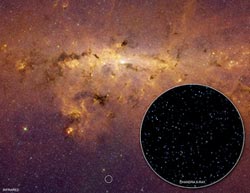Resolving a Galactic Mystery

X-ray: NASA/CXC/TUM/M.Revnivtsev et al.; IR: NASA/JPL-Caltech/GLIMPSE Team<br><br>This extremely deep Chandra X--ray Observatory image has resolved a long-standing mystery about an X-ray glow along the plane of the Milky Way. The Chandra results show that the X-ray emission in the region is caused by hundreds of point-like sources, implying that the glow along the plane of the Galaxy is due to millions of such sources. In this image, the Chandra field-of-view, a region located only about 1.4 degrees from the Galactic Center, is pulled out from an infrared image from the Spitzer Space Telescope.
The glow in the region covered by the Chandra image was discovered to be caused by hundreds of point-like X-ray sources, implying that the glow along the plane of the Galaxy is due to millions of such sources.
This image shows an infrared view from the Spitzer Space Telescope of the central region of the Milky Way, with a pullout showing a Chandra image of a region located only 1.4 degrees away from the center of the Galaxy.
The so-called Galactic ridge X-ray emission was first detected more than two decades ago using early X-ray observatories such as HEAO-1 and Exosat. The ridge was observed to extend about two degrees above and below the plane of the Galaxy and about 40 degrees along the plane of the galaxy on either side of the galactic center. It appeared to be diffuse.
One interpretation of the Galactic X-ray ridge was that it is emission from 100-million-degree gas. This interpretation is problematic because the disk of the Galaxy is not massive enough to confine such hot gas, which should flow away in a wind. Replenishing the gas would then be a problem, since plausible sources of energy such as supernovas are not nearly powerful enough.
A very deep Chandra observation, lasting for about 12 days, was used to study the nature of this ridge emission. The field was chosen to be close enough to the Galactic plane so that the ridge emission was strong, but in a region with relatively little absorption from dust and gas to maximize the number of sources that might be detected. A total of 473 sources were detected in an area on the sky only about 3% of the size of the full Moon, one of the highest densities of X-ray sources ever seen in our Galaxy.
It was found that more than 80% of the seemingly diffuse ridge of X-ray emission was resolved into individual sources. These are believed to be mostly white dwarfs pulling matter from companion stars and double stars with strong magnetic activity that are producing X-ray outbursts or flares that are similar to, but more powerful than the flares seen on the Sun. These stars are unrelated to the large-scale structures seen towards the center of the Spitzer image, which are probably caused by young massive stars.
The paper reporting these results appears in the April 30th issue of Nature. This work was led by Mikhail Revnivtsev from the Excellence Cluster Universe, Technical University Munich, in Garching, Germany, and from the Space Research Institute, in Moscow, Russia. The co-authors were Sergey Sasanov of the Space Research Institute in Moscow, Russia; Eugene Churazov of the Max Planck Institute for Astrophysics (MPA) in Garching, Germany; William Forman and Alexey Vikhlinin from the Harvard-Smithsonian Center for Astrophysics and Rashid Sunyaev from MPA.
NASA's Marshall Space Flight Center in Huntsville, Ala., manages the Chandra program for NASA's Science Mission Directorate in Washington. The Smithsonian Astrophysical Observatory controls Chandra's science and flight operations from Cambridge, Mass.
Media Contact
More Information:
http://www.cfa.harvard.eduAll latest news from the category: Physics and Astronomy
This area deals with the fundamental laws and building blocks of nature and how they interact, the properties and the behavior of matter, and research into space and time and their structures.
innovations-report provides in-depth reports and articles on subjects such as astrophysics, laser technologies, nuclear, quantum, particle and solid-state physics, nanotechnologies, planetary research and findings (Mars, Venus) and developments related to the Hubble Telescope.
Newest articles

Properties of new materials for microchips
… can now be measured well. Reseachers of Delft University of Technology demonstrated measuring performance properties of ultrathin silicon membranes. Making ever smaller and more powerful chips requires new ultrathin…

Floating solar’s potential
… to support sustainable development by addressing climate, water, and energy goals holistically. A new study published this week in Nature Energy raises the potential for floating solar photovoltaics (FPV)…

Skyrmions move at record speeds
… a step towards the computing of the future. An international research team led by scientists from the CNRS1 has discovered that the magnetic nanobubbles2 known as skyrmions can be…





















